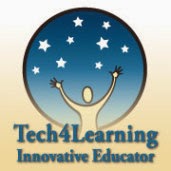One of my main goals this year as a language arts teacher is to
build a community of readers, writers and thinkers. I am employing several different strategies in pursuit of this aim. One of the most exciting and pleasurable is class read-alouds. A few months back, I read
Principal Joey's post "
Stop Trying to Make Your Kids Read." It really struck a chord with me, and I left this comment (which I am only partially sharing here because it was SO LONG)
I completely agree with you about reading aloud. In fact, I devote a LOT of time to read aloud with both my 4th and 5th grade classes, and that time is probably having the biggest impact of anything I am doing in my quest to create a true community of readers.
Some of the reasons I think that read aloud is so powerful in my classroom are:
•I give the students choice. I keep an ongoing list of recommended middle grade books that I am interested in reading. I choose about 5 of those and have the students privately vote via Google form. This way, each student can choose the one they really want, and no one knows who voted for what. This creates a feeling of ownership and excitement before we even begin reading.
•I am an avid, lifelong reader. Not only do I read very fluently, but I know where, when and how to stop and teach. I do not pre-plan my read aloud “lessons.” However, I use read-aloud to teach almost everything, from literary devices to vocabulary to reading strategies. I am able to do this because of the confidence I possess from being a real reader.
•The more we read together, the more shared history we have as a reading community. We naturally make text-to-text connections, and no one is left out.
I ended that comment with:
I have much more to say on this subject…I think I will write a post about read aloud!
I have so much to say about this I don't know where to begin!!!!
As a Teaching/Learning Tool
In my experience, reading aloud is a vital tool for teaching everything and anything about reading. I recommend reading the classic
Mosaic of Thought by Ellin Keene to understand how the act of making our thinking transparent during reading aloud helps children become better thinkers and readers. I also like the book
Constructing Meaning by Nancy Boyles. These signs, which hang on the wall all year long, are from that book and we refer to them frequently during discussions.
We also have great opportunity to discuss vocabulary strategies, and often students will request to add an interesting new word to our growing word wall.
My Non-Lesson Plan How-To
I do not write lesson plans for my read alouds. They evolve spontaneously. I attribute this to the fact that I do not "teach" reading so much as I share a genuine love of reading with my students. We choose, together as a class, books that no one (including me) has already read. I get recommendations from our
fabulous school librarian, as well as some amazing members of my PLN who are avid readers and reviewers of books for this age group.
The student librarians for each grade add the book to our read-alouds wall, and tag it "currently reading." After we finish the book, we go around the circle, and each student rates the book 1-5 stars, saying why they gave it the rating they did. The librarian keeps notes of each rating, figures out the class average and adds it to the wall.
Most activities during or immediately after reading are focused around discussions and written responses.
We have Skyped with other classes who are reading the same book, which has been a really fun experience. We have taken visual notes, written blog posts from the point of view of a particular character, written reviews on Goodreads, watched the movie and compared/contrasted book and movie, and in two weeks we will be Skyping with Holly Goldberg Sloan, the author of our latest read-aloud,
Counting By 7's.
We have discussed author's purpose, genre, metaphor, symbolism, word roots, and how authors sometimes "break the rules" of formal writing (which they are allowed to do because, presumably, they know the rules really well).
We use these books as "mentor texts" for our own writing, which is getting better and better as we grow our understanding of and appreciation for the craft.
What Do the Kids Say?
As much as I adore read-alouds, they do take time. And, like every teacher, I worry that there is never enough time to do everything. As a student-centered teacher, I value the input and opinions of my students, and I use surveys to gather this data. So I recently surveyed my classes to find out THEIR opinions of read-alouds.
Of my 30 students, I had one student say no and one say yes, after a short break. I also asked them to explain, in writing, their choice. Here are some of their responses:
I love read-alouds! I don't even want to think about stopping them, even for a short period of time. When you read aloud, you and other classmates help me understand things that I wouldn't understand if I read that book on my own. - Julia, 4th grade
I love the fact that I have been exposed to different genres that I wouldn't even think of checking. I think we should keep it going and read more. GO READALOUDS!!!!!!! - Jagger, 5th grade
I want to continue read alouds because when we finish a book, we want to read more books that are related to that book. I think it really helps people find the right books for them. -Nahila, 4th grade
I think we should keep doing read-alouds because it's a chance for everyone to settle down and get comfortable. For me, it helps write in different types of ways. -Arin, 5th grade
I would like to continue because they are fun to listen to and the story is always good. -Evan, 5th grade
Communities Share Stories
If you are still reading....you may be as passionate as I am about this topic. So you may enjoy this story that illustrates how reading aloud connects us as a community in special ways. I just finished reading
Wonderstruck by Brian Selznick with 4th grade. This incredible story is told partly through illustrations and partly through words. Towards the end of the book, the characters in the two stories meet up and the words and illustrations combine to tell the rest of the story.
When we got to this picture, I stopped reading for the day.
I challenged my students to use their iPads and what they knew to see if they could find out where the characters were. Several of them were excited that they were able to figure out that the characters were at the Queens Museum.
A few days later, I flew to New York for a conference. As the plane was landing at LaGuardia, I looked out the window to see that we were directly over this sight! My seatmate must have thought I was crazy as I scrambled to find my phone so I could take this photo for my students.
Further Reading
How a Reading Promise Can Forge Families and Shape Lives
Read Aloud: Why 15 Minutes a Day Matters
Matt Renwick's Top 10 Takeaways From the Read Aloud Handbook
The Warmth of a Shared Experience

+-+andrea.hernandez@mjgds.org+-+Martin+J.+Gottlieb+Day+School+Mail.jpg)


.jpg)








.JPG)
.JPG)



+on+Twitter.jpg)




